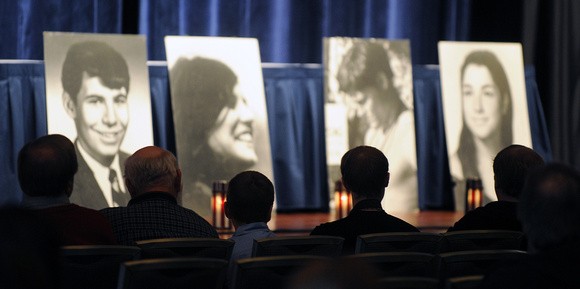The Kent State Massacre, where Ohio National Guardsmen fired upon unarmed student protesters on May 4, 1970, killing four and wounding nine, remains a pivotal moment in American history. This tragic event continues to spark debate and demands a thorough understanding of the historical context and contributing factors. This article explores the key question: Why Did The Kent State Massacre Happen?
The Escalation of Tensions at Kent State
The decision to deploy the National Guard to Kent State University was directly linked to the escalating tensions surrounding the Vietnam War. President Nixon’s announcement of the Cambodian invasion on April 30, 1970, ignited widespread protests across college campuses. At Kent State, a rally on May 1st included fiery speeches and symbolic acts of protest. That evening, demonstrations in downtown Kent turned violent, with property damage and confrontations with police. Fearing further unrest and fueled by rumors of radical revolutionaries, Mayor Leroy Satrom requested the National Guard’s presence.
The arrival of the Guard on May 2nd did little to quell the unrest. The ROTC building was set ablaze, and confrontations between protesters and Guardsmen continued through the night. On May 3rd, Governor James Rhodes further inflamed the situation with incendiary rhetoric, denouncing protesters and vowing to use force. A de facto state of martial law was assumed, with the Guard in control of the campus and rallies banned.
The Rally and the Shootings of May 4th
Despite the ban, a rally convened on the Commons on May 4th. Approximately 3,000 people gathered, a mix of protesters, supporters, and onlookers. The rally was met by approximately 100 National Guardsmen armed with M-1 rifles. After attempts to disperse the crowd with tear gas and verbal warnings failed, the Guard advanced across the Commons.
The protesters retreated up Blanket Hill and then down onto a practice football field. Trapped and facing a barrage of rocks and verbal abuse, the Guard retreated back up the hill. At the top, 28 Guardsmen suddenly turned and fired into the crowd. The 13-second volley resulted in the deaths of four students – Jeffrey Miller, Allison Krause, William Schroeder, and Sandra Scheuer – and the wounding of nine others.
The Unanswered Question: Why Did They Fire?
The central question remains: why did the Guardsmen fire? The Guardsmen claimed self-defense, stating they feared for their lives. This position was upheld in the 1974 federal criminal trial and the initial 1975 civil trial (later overturned). However, many dispute this claim, citing the distance of most victims from the Guard and the lack of evidence of imminent threat. The Scranton Commission concluded that the shootings were “unnecessary, unwarranted, and inexcusable.”
Several theories point to a possible conspiracy among some Guardsmen to fire, while others suggest a combination of fear, panic, and poor training contributed to the tragedy. The lack of clear answers continues to fuel debate.
The Aftermath and Lasting Significance
The immediate aftermath of the shootings was fraught with tension. The potential for further violence was averted by the intervention of Kent State faculty, who persuaded the students to disperse. The university closed for six weeks, and the nation grappled with the implications of the tragedy.
The Kent State Massacre remains a potent symbol of the deep divisions and turmoil of the Vietnam War era. The Pulitzer Prize-winning photograph of Mary Vecchio screaming over Jeffrey Miller’s body became an iconic image of the era. The event forced a national reckoning with issues of protest, freedom of speech, and the use of military force against civilians.
The massacre also highlighted the importance of accurate historical accounts. Misinformation and conflicting narratives persist, underscoring the need for continued research and open dialogue. Ultimately, understanding the Kent State Massacre serves as a reminder of the fragility of peace and the importance of learning from the mistakes of the past. It remains a crucial event to study and understand for future generations.
